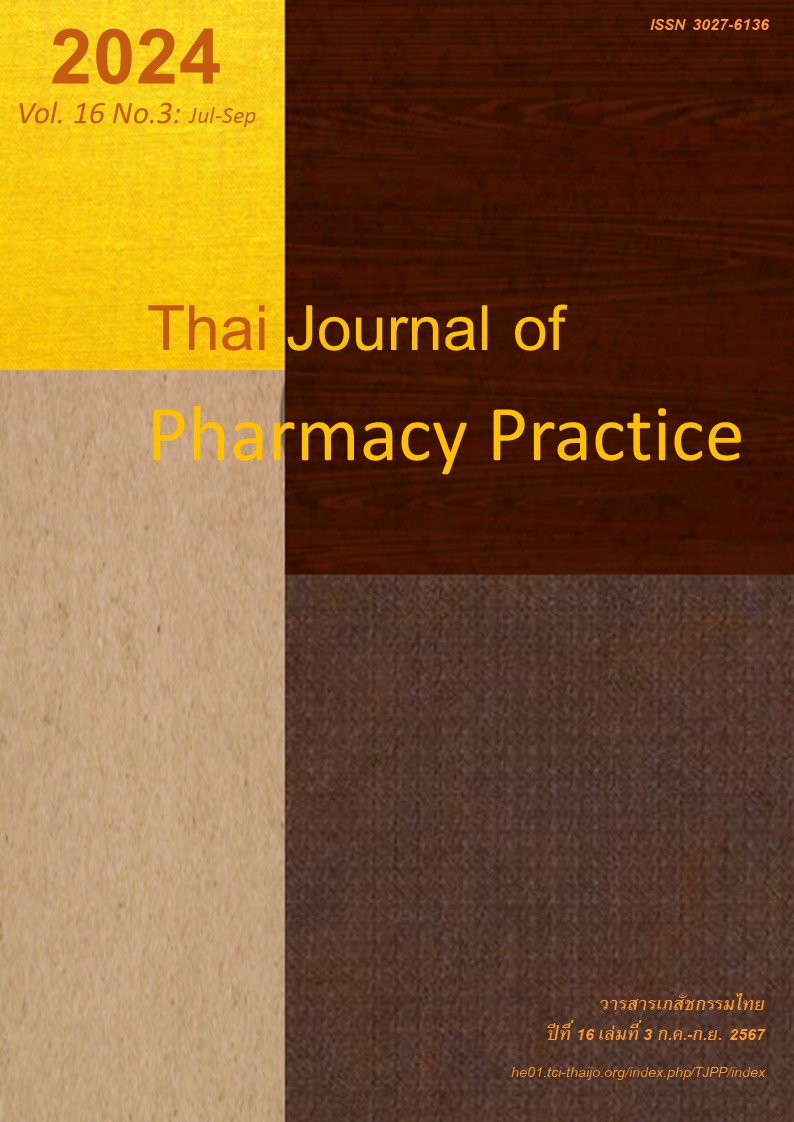ผลลัพธ์ของการบริบาลทางเภสัชกรรมเชิงรุกแก่ผู้ป่วยวัณโรคประเภท ผู้ป่วยใน ณ โรงพยาบาลระดับทุติยภูมิแห่งหนึ่งในจังหวัดสมุทรสาคร
Main Article Content
บทคัดย่อ
วัตถุประสงค์: เพื่อประเมินผลลัพธ์ของการบริบาลทางเภสัชกรรมเชิงรุกแก่ผู้ป่วยวัณโรคในด้านการค้นพบและแก้ไขปัญหาการใช้ยาและในด้านผลลัพธ์ของการรักษาเปรียบเทียบกับการบริบาลทางเภสัชกรรมตามปกติ วิธีการ: การวิจัยกึ่งทดลองครั้งนี้ทำในกลุ่มตัวอย่างซึ่งเป็นผู้ป่วยในที่เพิ่งได้รับการวินิจฉัยว่าเป็นวัณโรคจำนวน 31 คน โดยแบ่งเป็นกลุ่มศึกษา 15 คนและกลุ่มควบคุม 16 คน ในกลุ่มควบคุม ผู้วิจัยเก็บข้อมูลย้อนหลังจากเวชระเบียนโดยผู้ป่วยได้รับการบริบาลทางเภสัชกรรมแบบปกติ ในกลุ่มศึกษา ทำการศึกษาไปข้างหน้า ผู้ป่วยได้รับการบริบาลทางเภสัชกรรมเชิงรุกโดยการค้นหาและแก้ไขปัญหาการใช้ยาในช่วงที่ผู้ป่วยนอนรักษาตัวในโรงพยาบาล หลังออกจากโรงพยาบาลมีการโทรศัพท์ติดตามผู้ป่วยที่บ้านในวันที่ 3, 7, 14, 21, 28, 35, 42, 49, 56 หรือ 60 และเมื่อผู้ป่วยมาพบแพทย์ตามนัดต่อเนื่องจนสิ้นสุดการรักษาในระยะเข้มข้น การศึกษาวัดผลลัพธ์ของการรักษาที่ 2 เดือนและ 6 เดือน ผลการวิจัย: ในกลุ่มศึกษาค้นพบปัญหาจากการใช้ยามากกว่ากลุ่มควบคุม (P=0.013) สามารถจัดการปัญหาได้ร้อยละ 100.0 และมีความทันเวลาในการแก้ไขปัญหาร้อยละ 84.9 มากกว่ากลุ่มควบคุม (ร้อยละ 84.8, P=0.001 และร้อยละ 30.4, P < 0.05 ตามลำดับ) กลุ่มศึกษามาพบแพทย์ตามนัดหมายมากกว่ากลุ่มควบคุม (ร้อยละ 100.0 และ 81.6 ตามลำดับ, P =0.012) ค่าเฉลี่ยของร้อยละของความร่วมมือในการใช้ยาในกลุ่มศึกษาเท่ากับ 96.46 ± 4.09 กลุ่มศึกษาร้อยละ 66.7 และ 86.7 บรรลุเป้าหมายของการรักษาเมื่อสิ้นสุดการรักษาระยะเข้มข้นและเมื่อสิ้นสุดการรักษา 6 เดือน ตามลำดับ มากกว่ากลุ่มควบคุมที่พบร้อยละ 43.8 (P = 0.285) และ 68.8 (P = 0.394) ตามลำดับ แต่ไม่มีนัยสำคัญทางสถิติ สรุป: การบริบาลทางเภสัชกรรมเชิงรุกให้ผลลัพธ์ที่ดีกว่าการบริบาลทางเภสัชกรรมแบบปกติในด้านการค้นพบและแก้ไขปัญหาจากการใช้ยา และยังมีแนวโน้มที่ผลลัพธ์ของการรักษาจะดีกว่าแม้จะไม่พบความแตกต่างกันอย่างมีนัยสำคัญทางสถิติ การนำการบริบาลทางเภสัชกรรมเชิงรุกไปใช้ดูแลผู้ป่วยวัณโรคจึงน่าจะเกิดประโยชน์ต่อผู้ป่วย
Article Details

อนุญาตภายใต้เงื่อนไข Creative Commons Attribution-NonCommercial-NoDerivatives 4.0 International License.
ผลการวิจัยและความคิดเห็นที่ปรากฏในบทความถือเป็นความคิดเห็นและอยู่ในความรับผิดชอบของผู้นิพนธ์ มิใช่ความเห็นหรือความรับผิดชอบของกองบรรณาธิการ หรือคณะเภสัชศาสตร์ มหาวิทยาลัยสงขลานครินทร์ ทั้งนี้ไม่รวมความผิดพลาดอันเกิดจากการพิมพ์ บทความที่ได้รับการเผยแพร่โดยวารสารเภสัชกรรมไทยถือเป็นสิทธิ์ของวารสารฯ
เอกสารอ้างอิง
Division of Tuberculosis. National tuberculosis control program guideline, Thailand 2021. Bangkok: Division of Tuberculosis; 2021.
World Health Organization. Global tuberculosis report [online] 2021. [cited Apr 20, 2023]. Available from: www.who.int/publications/i/item/9789240037021
Division of Tuberculosis. National tuberculosis control program guideline, Thailand 2018. Bangkok: Division of Tuberculosis; 2018.
Division of Tuberculosis. Thailand’s operational plan to end TB 2017-2021. Bangkok: Division of Tuberculosis; 2017.
Office of the Permanent Secretary Ministry of Public Health. Template key performance indicator of Ministry of Public Health 2022. Bangkok: Strategy and Planning Division; 2022
Division of Tuberculosis. Clinical practice guideline of tuberculosis treatment in Thailand 2021. Bangkok: Division of Tuberculosis; 2019.
Nahid P, Dorman SE, Alipanah N, Barry PM, Brozek JL, Cattamanchi A, et al. Executive summary: Official American Thoracic Society/Centers for Disease Control and Prevention/Infectious Diseases Society of America clinical practice guidelines: Treatment of drug-susceptible tuberculosis. Clin Infect Dis. 2016; 63: 853-67. doi: 10.1093/cid/ciw 566.
Phummangkul C. Philosophy of pharmaceutical care practice. Bangkok: Newthaimit; 2000.
Strand LM, Cipolle RJ, Morley PC, et al. Drug therapy problems: nature, structure, and solutions. 2nd ed. Philadelphia: Lippincott Williams & Wilkins; 2004.
Hepler CD, Strand LM. Opportunities and responsi bilities in pharmaceutical care. Am J Hosp Pharm 1990; 47: 533-43.
Ramirez-Mendoza D, Trejo-Gutierrez JF, Alcala-Mar tinez E, et al. Evaluation of pharmaceutical care for patients with pulmonary tuberculosis. Int J Clin Pharm 2016; 338: 1365-72.
Lopes ARV, Miranda SS, Ceccato MDGB, Silveira MR, Resende NH, Carvalho WS. Evaluation of the impact of pharmaceutical care for tuberculosis patients in a Secondary Referral Outpatient Clinic, Minas Gerais, Brazil. An Acad Bras Cienc 2017; 89: 2911-9. doi: 10.1590/0001-3765201720170301.
Yusook S. Outcomes of pharmaceutical care in pul- monary tuberculosis patients at Prasat Hospital Surin province [master thesis]. Chiang Mai: Chiang Mai University; 2008.
Supongpattanakit S. Drug-related problems in pul- mo nary tuberculosis patients at Tuberculosis Control Center 10 Chiang Mai [independent study]. Chiang Mai: Chiang Mai University; 2000.
Tanvejsilp P, Pullenayegum E, Loeb M, Dushoff J, Xie F. Role of pharmaceutical care for self-administered pulmonary tuberculosis treatment in Thailand. J Clin Pharm Ther 2017; 42: 337-44.
Tang Z, Jiang R, Xu H. Effectiveness of pharmaceu- tical care on treatment outcomes for patients with first-time pulmonary tuberculosis in China. J Clin Pharm Ther 2018; 43: 888-94.
Tassanavijitr P. The clinical outcomes of pharmaceu tical care on tuberculosis patients at Ngao hospital Lampang province [master thesis]. Chiang Mai: Chiang Mai University; 2003.
Khamduang N. Outcomes of pharmaceutical care in pulmonary tuberculosis at Somdejprasangkharach XVII hospital Suphanburi [master thesis]. Phitsanu lok: Naresuan University; 2017.
Clark PM, Karagoz T, Apikoglu-Rabus S, Izzettin FV. Effect of pharmacist-led patient education on adherence to tuberculosis treatment. Am J Health Syst Pharm. 2007; 64: 497-505.
Kurnia AD, Ni’mah IH, Masruroh NL, Melizza N. Effect of counselling on medication adherence in TB patients with the DOTS strategy: A scoping review. Jurnal Ilmu Kesehatan 2021; 6: 773–80. DOI : 10.30604/jika.v6i4.762
Stuurman-Bieze, AGG, Hiddink EG, Boven JFM, Vegter S. Proactive pharmaceutical care interven- tions improve patients' adherence to lipid-lowering medication. Ann Pharmacother. 2013; 47: 1448-56. doi: 10.1177/1060028013501146.
Stuurman-Bieze, AGG, Hiddink EG, Boven JFM, Vegter S. Proactive pharmaceutical care interven- tions decrease patients' non-adherence to osteopo rosis medication. Osteoporos Int 2014; 25: 1807-12. doi: 10.1007/s00198-014-2659-8.
Kantared M. Outcome of pharmaceutical care in patients with new smear pulmonary tuberculosis at Uttaradit hospital. Health Science Clinical Research. 2020; 35: 21-32.
Sathapornnanon N. Medication non-adherence. Thai Bulletin of Pharmaceutical Sciences. 2012; 7: 1-18.
Srisatidnarakul B. Methodology in nursing research 3rd ed. Bangkok: U&I Inter Media; 2004.
Songmuang A, Songmuang T, Jampasa N. Out- come of diabetic patient management by proactive pharmaceutical care service. Srinagarind Medical Journal 2017; 32: 236-43.
Namsaeng C, Hachai W. Factors associated with extended duration of treatment in new smear positive pulmonary tuberculosis patients in Bandung Crown Prince Hospital, Udonthani Province. Journal of the Department of Medical Service 2022; 64:45-9
World Health Organization. Global tuberculosis report 2020. Geneva: World Health Organization; 2020.
Satyanarayana S, Subbaraman R, Shete P, Gore G, Das J, Cattamanchi A, et al. Quality of tubercu losis care in India: a systematic review. Int J Tuberc Lung Dis 2015; 19: 751-63. doi: 10.5588/ijtld.15.01 86.
Alipanah N, Jarlsberg L, Miller C, Linh N, Falzon D, Jaramillo E, et al. Adherence interventions and outcomes of tuberculosis treatment: A systematic review and meta-analysis of trials and observational studies. PLoS Med 2018; 15: e1002595. doi: 10.137 1/journal.pmed.1002595.
Sirijaichingkul C, Pimpasung J, Choroensri S. Inci dence of tuberculosis and factors affecting treatment outcomes in Chum Phae hospital. KKU Journal of Medicine. 2018; 4: 37-44.
Tanthanasuwat N, Kaewkitnarong K, Suwanpimolkul G, Puttilerpong C. Treatment outcomes and factors associated with treatment success among adult patients with pulmonary tuberculosis at airborne infection clinic. Thai Journal of Pharmacy Practice 2023; 15: 375-88.


